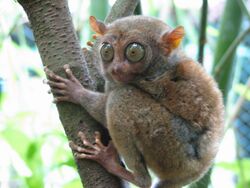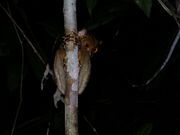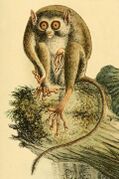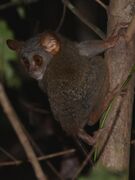Biology:List of tarsiiformes
Template:Featured list is only for Wikipedia:Featured lists.
Tarsiiformes is an infraorder of small primates. It contains a single extant family, Tarsiidae, and members of this infraorder are called tarsiiformes, with members of the family named tarsiers. Tarsiiformes is one of the six major groups in the order Primates. They are found in Maritime Southeast Asia, primarily in forests, though some species can also be found in caves or wetlands. They range in size from the pygmy tarsier, at 8 cm (3 in) plus a 20 cm (8 in) tail, to the Philippine tarsier, at 16 cm (6 in) plus a 25 cm (10 in) tail. Tarsiers are carnivorous and primarily eat insects, though they also consume small vertebrates such as lizards, birds, or bats. The only tarsier with a population estimate is Niemitz's tarsier, estimated at 10,000 to 20,000 mature individuals, but it, along with the Peleng tarsier, pygmy tarsier, and Sangihe tarsier, is categorized as endangered species, while the Siau Island tarsier is classified as critically endangered.
The fourteen extant species of Tarsiiformes are divided into three genera: Carlito and Cephalopachus, each with a single species, and Tarsius, containing the other twelve. A few extinct prehistoric Tarsiiformes species have been discovered, though due to ongoing research and discoveries the exact number and categorization is not fixed.[1]
Conventions
Conservation status codes listed follow the International Union for Conservation of Nature (IUCN) Red List of Threatened Species. Range maps are provided wherever possible; if a range map is not available, a description of the tarsier's range is provided. Ranges are based on the IUCN Red List for that species unless otherwise noted.
Classification
The infraorder Tarsiiformes consists of one extant family: Tarsiidae, containing fourteen species divided between three genera. Carlito and Cephalopachus each have a single species, and Tarsius contains the other twelve.
Family Tarsiidae
- Genus Carlito (Philippine tarsier): one species
- Genus Cephalopachus (Horsfield's tarsier): one species
- Genus Tarsius (tarsiers): twelve species
Tarsiiformes
The following classification is based on the taxonomy described by the reference work Mammal Species of the World (2005), with augmentation by generally accepted proposals made since using molecular phylogenetic analysis, as supported by both the IUCN and the American Society of Mammalogists.[2]
Family Tarsiidae
| Common name | Scientific name and subspecies | Range | Size and ecology | IUCN status and estimated population |
|---|---|---|---|---|
| Philippine tarsier | C. syrichta (Linnaeus, 1758) |
Southeastern Philippines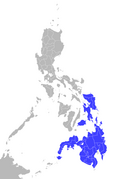
|
Size: 8–16 cm (3–6 in) long, plus about 25 cm (10 in) tail[3] Habitat: Forest[4] Diet: Insects, spiders, lizards, and other small vertebrates[3] |
NT
|
| Common name | Scientific name and subspecies | Range | Size and ecology | IUCN status and estimated population |
|---|---|---|---|---|
| Horsfield's tarsier | T. bancanus (Horsfield, 1821) Three subspecies
|
Western Philippines
|
Size: 11–15 cm (4–6 in) long, plus 20–24 cm (8–9 in) tail[5] Habitat: Forest[6] Diet: Insects, as well as small vertebrates including birds, mammals, and reptiles[7] |
VU
|
| Common name | Scientific name and subspecies | Range | Size and ecology | IUCN status and estimated population |
|---|---|---|---|---|
| Dian's tarsier | T. dentatus Miller & Hollister, 1921 |
Central Sulawesi, Indonesia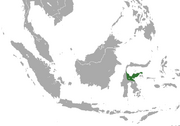
|
Size: 11–12 cm (4–5 in) long, plus 13–28 cm (5–11 in) tail[8][9] Habitat: Forest[10] Diet: Insects, as well as small vertebrates[8] |
VU
|
| Gursky's spectral tarsier | T. spectrumgurskyae Shekelle, Groves, Maryanto & Mittermeier, 2017 |
Northeastern Sulawesi (in purple)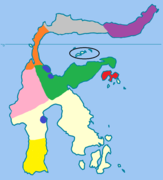
|
Size: About 14 cm (6 in) long, plus 21–27 cm (8–11 in) tail[11] Habitat: Forest[12] Diet: Insects, as well as small vertebrates[12] |
VU
|
| Jatna's tarsier | T. supriatnai Shekelle, Groves, Maryanto & Mittermeier, 2017 |
Northern Sulawesi (in gray)
|
Size: About 14 cm (6 in) long, plus 23–25 cm (9–10 in) tail[11] Habitat: Forest[13] Diet: Insects, as well as small vertebrates[13] |
VU
|
| Lariang tarsier | T. lariang Groves & Merker, 2006 |
Central Sulawesi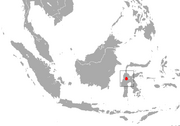
|
Size: About 12 cm (5 in) long, plus 12–21 cm (5–8 in) tail[14] Habitat: Forest[15] Diet: Insects, as well as small vertebrates[15] |
DD
|
| Makassar tarsier | T. fuscus Fischer von Waldheim, 1804 |
Southern Sulawesi (in yellow)
|
Size: 12–13 cm (5 in) long, plus 24–26 cm (9–10 in) tail[16] Habitat: Forest and caves[17] Diet: Insects, as well as small vertebrates[16] |
VU
|
| Niemitz's tarsier | T. niemitzi Shekelle, Groves, Maryanto, Mittermeier, Salim & Springer, 2019 |
Northern Sulawesi (circled in black)
|
Size: About 14 cm (6 in) long, plus 24–26 cm (9–10 in) tail[18] Habitat: Forest[19] Diet: Insects, as well as small vertebrates[19] |
EN
|
| Peleng tarsier | T. pelengensis Sody, 1949 |
Eastern Sulawesi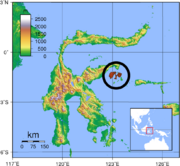
|
Size: 12–14 cm (5–6 in) long, plus 25–27 cm (10–11 in) tail[20] Habitat: Forest[21] Diet: Insects, as well as frogs, lizards, and other small vertebrates[21] |
EN
|
| Pygmy tarsier | T. pumilus Miller, Hollister, 1921 |
Central Sulawesi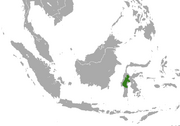
|
Size: 8–11 cm (3–4 in) long, plus 20–21 cm (8 in) tail[22][23] Habitat: Forest[24] Diet: Arthropods and insects, as well as small vertebrates[22] |
EN
|
| Sangihe tarsier | T. sangirensis Meyer, 1897 |
Sangir Island, southeastern Philippines
|
Size: 12–13 cm (5 in) long, plus about 30 cm (12 in) tail[25] Habitat: Forest and inland wetlands[26] Diet: Insects, as well as birds, lizards, and other small vertebrates[25] |
EN
|
| Siau Island tarsier | T. tumpara Shekelle, Groves, Merker & Supriatna, 2008 |
Siau Island, north of Sulawesi | Size: 10–15 cm (4–6 in) long, plus about 20 cm (8 in) tail[27] Habitat: Forest[28] Diet: Arthropods, as well as small vertebrates[28] |
CR
|
| Spectral tarsier | T. tarsier (Erxleben, 1777) |
Sulawesi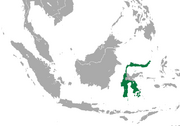
|
Size: 9–14 cm (4–6 in) long, plus 20–26 cm (8–10 in) tail[29] Habitat: Forest[30] Diet: Insects, as well as lizards, bats, and other small vertebrates[29] |
VU
|
| Wallace's tarsier | T. wallacei Merker, Driller, Dahruddin, Wirdateti, Sinaga, Perwitasari-Farajallah & Shekelle, 2010 |
Northern Sulawesi (in orange)
|
Size: 11–13 cm (4–5 in) long, plus 23–27 cm (9–11 in) tail[31] Habitat: Forest and inland wetlands[32] Diet: Insects, as well as small vertebrates[31] |
VU
|
References
- ↑ "Fossilworks: Tarsiiformes". Paleobiology Database. University of Wisconsin–Madison. http://www.fossilworks.org/cgi-bin/bridge.pl?a=taxonInfo&taxon_no=40792.
- ↑ Wilson, Reeder, pp. 127-128
- ↑ Jump up to: 3.0 3.1 Kubicek, Carissa (2023). "Tarsius syrichta". University of Michigan. https://animaldiversity.org/accounts/Tarsius_syrichta/.
- ↑ Jump up to: 4.0 4.1 Shekelle, M. (2020). "Carlito syrichta". IUCN Red List of Threatened Species 2020: e.T21492A17978520. doi:10.2305/IUCN.UK.2020-3.RLTS.T21492A17978520.en. https://www.iucnredlist.org/species/21492/17978520.
- ↑ Downey, Kathleen (June 2017). "Horsfield's Tarsier, Cephalopachus bancanus". https://neprimateconservancy.org/horsfields-tarsier/.
- ↑ Jump up to: 6.0 6.1 Shekelle, M.; Yustian, I. (2020). "Cephalopachus bancanus". IUCN Red List of Threatened Species 2020: e.T21488A17976989. doi:10.2305/IUCN.UK.2020-3.RLTS.T21488A17976989.en. https://www.iucnredlist.org/species/21488/17976989.
- ↑ McKeighan, Paul (2011). "Tarsius bancanus". University of Michigan. https://animaldiversity.org/accounts/Tarsius_bancanus/.
- ↑ Jump up to: 8.0 8.1 Yang, Liubin (2007). "Tarsius dentatus". University of Michigan. https://animaldiversity.org/accounts/Tarsius_dentatus/.
- ↑ Supriatna, p. 49
- ↑ Jump up to: 10.0 10.1 Shekelle, M. (2020). "Tarsius dentatus". IUCN Red List of Threatened Species 2020: e.T21489A17977790. doi:10.2305/IUCN.UK.2020-3.RLTS.T21489A17977790.en. https://www.iucnredlist.org/species/21489/17977790.
- ↑ Jump up to: 11.0 11.1 Shekelle, M.; Groves, C. P.; Maryanto, I.; Mittermeier, R. A. (2017). "Two new tarsier species (Tarsiidae, Primates) and the biogeography of Sulawesi, Indonesia". Primate Conservation 31: 61–69.
- ↑ Jump up to: 12.0 12.1 12.2 Shekelle, M. (2020). "Tarsius spectrumgurskyae". IUCN Red List of Threatened Species 2020: e.T162336422A162336580. doi:10.2305/IUCN.UK.2020-3.RLTS.T162336422A162336580.en. https://www.iucnredlist.org/species/162336422/162336580.
- ↑ Jump up to: 13.0 13.1 13.2 Shekelle, M. (2020). "Tarsius supriatnai". IUCN Red List of Threatened Species 2020: e.T162336881A220971513. doi:10.2305/IUCN.UK.2020-3.RLTS.T162336881A220971513.en. https://www.iucnredlist.org/species/162336881/220971513.
- ↑ Supriatna, p. 45
- ↑ Jump up to: 15.0 15.1 15.2 Shekelle, M; Salim, M.; Merker, S. (2020). "Tarsius lariang". IUCN Red List of Threatened Species 2020: e.T136319A17978130. doi:10.2305/IUCN.UK.2020-3.RLTS.T136319A17978130.en. https://www.iucnredlist.org/species/136319/17978130.
- ↑ Jump up to: 16.0 16.1 Supriatna, pp. 40–41
- ↑ Jump up to: 17.0 17.1 Shekelle, M. (2020). "Tarsius fuscus". IUCN Red List of Threatened Species 2020: e.T162369593A162369616. doi:10.2305/IUCN.UK.2020-3.RLTS.T162369593A162369616.en. https://www.iucnredlist.org/species/162369593/162369616.
- ↑ Shekelle, M.; Groves, C. P.; Maryanto, I/; Mittermeier, R. A.; Salim, A/; Springer, M/ S. (2019). "A new tarsier species from the Togean Islands of Central Sulawesi, Indonesia, with references to Wallacea and conservation on Sulawesi". Primate Conservation 33: 1–9.
- ↑ Jump up to: 19.0 19.1 19.2 Shekelle, M. (2020). "Tarsius niemitzi". IUCN Red List of Threatened Species 2020: e.T162337005A171341769. doi:10.2305/IUCN.UK.2020-3.RLTS.T162337005A171341769.en. https://www.iucnredlist.org/species/162337005/171341769.
- ↑ Supriatna, p. 53
- ↑ Jump up to: 21.0 21.1 21.2 Shekelle, M. (2020). "Tarsius pelengensis". IUCN Red List of Threatened Species 2020: e.T21494A17977515. doi:10.2305/IUCN.UK.2020-3.RLTS.T21494A17977515.en. https://www.iucnredlist.org/species/21494/17977515.
- ↑ Jump up to: 22.0 22.1 Ford, Trevor (2011). "Tarsius pumilus". University of Michigan. https://animaldiversity.org/accounts/Tarsius_pumilus/.
- ↑ Supriatna, pp. 42–43
- ↑ Jump up to: 24.0 24.1 Shekelle, M; Salim, A. (2020). "Tarsius pumilus". IUCN Red List of Threatened Species 2020: e.T21490A17977980. doi:10.2305/IUCN.UK.2020-3.RLTS.T21490A17977980.en. https://www.iucnredlist.org/species/21490/17977980.
- ↑ Jump up to: 25.0 25.1 Minich, Miriam (2017). "Tarsius sangirensis". University of Michigan. https://animaldiversity.org/accounts/Tarsius_sangirensis/.
- ↑ Jump up to: 26.0 26.1 Shekelle, M. (2020). "Tarsius sangirensis". IUCN Red List of Threatened Species 2020: e.T21493A17977351. doi:10.2305/IUCN.UK.2020-3.RLTS.T21493A17977351.en. https://www.iucnredlist.org/species/21493/17977351.
- ↑ Downey, Kathleen (March 2019). "Siau Island Tarsier, Tarsius tumpara". https://neprimateconservancy.org/siau-island-tarsier/.
- ↑ Jump up to: 28.0 28.1 28.2 Shekelle, M; Salim, A. (2020). "Tarsius tumpara". IUCN Red List of Threatened Species 2020: e.T179234A17977202. doi:10.2305/IUCN.UK.2020-3.RLTS.T179234A17977202.en. https://www.iucnredlist.org/species/179234/17977202.
- ↑ Jump up to: 29.0 29.1 Mogk, Kenzie (2012). "Tarsius tarsier". University of Michigan. https://animaldiversity.org/accounts/Tarsius_tarsier/.
- ↑ Jump up to: 30.0 30.1 Shekelle, M. (2020). "Tarsius tarsier". IUCN Red List of Threatened Species 2020: e.T162369551A17978304. doi:10.2305/IUCN.UK.2020-3.RLTS.T162369551A17978304.en. https://www.iucnredlist.org/species/162369551/17978304.
- ↑ Jump up to: 31.0 31.1 Supriatna, pp. 47–48
- ↑ Jump up to: 32.0 32.1 Merker, S.; Shekelle, M. (2020). "Tarsius wallacei". IUCN Red List of Threatened Species 2020: e.T195277A17977659. doi:10.2305/IUCN.UK.2020-3.RLTS.T195277A17977659.en. https://www.iucnredlist.org/species/195277/17977659.
Sources
- Mammal Species of the World. 1 (3rd ed.). Johns Hopkins University Press. 2005. ISBN 978-0-8018-8221-0.
- Supriatna, Jatna (2022). Field Guide to the Primates of Indonesia. Springer Nature. ISBN 978-3-03-083206-3.
 |
